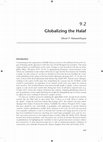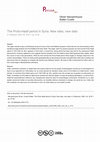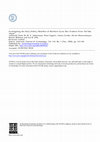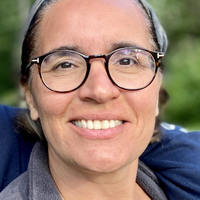Papers by Olivier Nieuwenhuyse

Commenting on the organization of Middle Eastern societies in the millennia between the origins o... more Commenting on the organization of Middle Eastern societies in the millennia between the origins of farming and the appearance of the first cities, David Wengrow has remarked, ‘This much neglected phase in world history needs a name. Perhaps it is best described as the first era of the global village’. In appropriating Wengrow’s characterization of the Ubaid, my contribution to this volume will not be to argue that the Near Eastern Late Neolithic is simply ‘an early version of’, nor that we should trace back into the Late Neolithic the ‘roots’ of the globalizing Uruk cultures of the later fourth millennium or those of the third millennium Early Bronze Age. Indeed, many colleagues working in the region would argue that extrapolating the concept into the Neolithic world would be anachronistic, an imposition of our modern world views onto others far removed from ourselves. Nor would prehistoric interactions literally qualify as ‘global’, as they connected regions at scales much more modest than during later times of urbanized, imperial states. Adapting globalization theory to just any prehistoric society might risk losing out of sight the distinguishing aspects of this concept to explain the inner workings of advanced, complex societies. Yet there are excellent reasons for exploring the applicability...
This paper presents a review of the ceramic investigations at the Late Neolithic site of Shir. Si... more This paper presents a review of the ceramic investigations at the Late Neolithic site of Shir. Situated in Western Syria the site occupies a central position in the so-called 'Levantine corridor', which linked the southern Levant, Central Anatolia, and Upper Mesopotamia in the Neolithic. The ceramic sequence covers a period of several centuries between c. 7000 and 6450 cal BC. The pottery analysis combined bulk processing in the field and archaeometric work in the laboratory to construct a viable ceramic categorization. This paper discusses long-term ceramic trends that follow the first appearance of pottery in the northern Levant, including the development of pottery containers for storage.
The paper presents the results of a chemical analysis of black pigment used to decorate pottery f... more The paper presents the results of a chemical analysis of black pigment used to decorate pottery from Late Neolithic Tell Sabi Abyad, northern Syria (c. 6100 cal BC). The pigment appears to be bitumen. A comparison with known reference samples from modern locations of bituminous sources in the Near East suggests that the bitumen used to paint ceramics at Tell Sabi Abyad came from at least two different source areas in northern Iraq. The bitumen-painted ceramics at Tell Sabi Abyad represent the earliest evidence attested so far of bitumen used as a pigment for pottery decoration.

Paléorient, 2004
This paper intends to give a brief factual account of some of the new fieldwork projects in Syria... more This paper intends to give a brief factual account of some of the new fieldwork projects in Syria that are now documenting a short transitional stage between the Pre-Halafand the Early Halaf. This stage, which for present purposes we have termed Proto-Halaf (about 6 100-5 950 cal. ВС), appears to have been a crucial time, during which the basis was laid for the subsequent Halaf phenomenon. Evidence gathered so far suggests that the transition from Pre-Halaf to Early Halaf happened fairly rapidly, within the course of only a few generations. What we have termed the Proto-Halaf period refers largely to changes observed in the ceramic assemblages. These we shall present geographically by discussing previously excavated sites while also including new discoveries that are changing our insights with almost every fieldwork season. We hope to offer a framework for further work on this crucial stage in Mesopotamian prehistory.

Paléorient, Jan 1, 2004
This paper intends to give a brief factual account of some of the new fieldwork projects in Syria... more This paper intends to give a brief factual account of some of the new fieldwork projects in Syria that are now documenting a short transitional stage between the Pre-Halafand the Early Halaf. This stage, which for present purposes we have termed Proto-Halaf
(about 6 100-5 950 cal. ВС), appears to have been a crucial time, during which the basis was laid for the subsequent Halaf
phenomenon. Evidence gathered so far suggests that the transition from Pre-Halaf to Early Halaf happened fairly rapidly, within the course of only a few generations. What we have termed the Proto-Halaf period refers largely to changes observed in the ceramic assemblages. These we shall present geographically by discussing previously excavated sites while also including new discoveries that are changing our insights with almost every fieldwork season. We hope to offer a framework for further work on this crucial stage in Mesopotamian prehistory.
Paléorient 38.1, Jan 24, 2013
In this paper we present a textile imprint observed on a prehistoric (Late Neolithic) sherd recov... more In this paper we present a textile imprint observed on a prehistoric (Late Neolithic) sherd recovered from the site of Bestansur, Northern Iraq. Dated to ca 6500-6200 cal. BC, this represents one of the earliest textile imprints in the region. We discuss the fi nd and the type of textile. Rather tentatively we suggest it may have been used as a "fi shing net". Résumé : Nous présentons ici une empreinte de textile observée sur un tesson préhistorique (Néolithique fi nal) découvert sur le site de Bestansur, Iraq du nord. Datée de ca 6500-6200 cal. BC, cette trouvaille représente une des plus anciennes empreintes textiles de la région. On discute cette découverte et le type de textile représenté. À titre d'hypothèse, on suggère qu'il a pu s'agir d'un « fi let de pêche ».
... van As, T. Broekmans and AM. Adriaens. earlier, Pre-Halaf pottery traditions and the earliest... more ... van As, T. Broekmans and AM. Adriaens. earlier, Pre-Halaf pottery traditions and the earliest Halaf. The Hassuna/Samarra period (ca. ... Fig. 1 : Principal sites mentioned in the text. excavated in Pre-Halaf to Early Halaf Transitional contexts (fig. I)6. ...

Abstract:
Late Neolithic settlements dating to around 7000 cal. BC are widespread in Upper Mesop... more Abstract:
Late Neolithic settlements dating to around 7000 cal. BC are widespread in Upper Mesopotamia, however, the site of Tell Sabi Abyad is unique in the scale and quality of excavation, revealing an extensive architecture, huge numbers of domesticated animal bones, stone tools and potsherds. A previous study reported lipid residues in nearly 300 potsherds as part of a wider investigation of the origins of dairying in the Near East and Southeastern Europe. The aim of this paper is to interpret the organic residue findings in more detail, addressing such factors as the association of lipids in pottery with particular phases, ware types, and the faunal record. Overall, the recovery rate of lipids in sherds is low (14 % of the sherds investigated in this study yielded detectable lipids) and the mean lipid concentration for sherds containing lipids is ca. 82 µg g-1. These results are typical of sites from this period and general region (southern Mediterranean and Near East). Our interpretations indicate: (i) the use of specific ceramic categories of vessel for “cooking”, (ii) clear evidence of the extensive heating of vessels is deduced from the presence of ketones, formed from the condensation of fatty acids, in some vessels, (iii) strong differences in recovery rates possibly reflecting differences in use between different pottery types, (iv) in particular the Dark Faced Burnished Ware (DFBW) contained the highest frequency of residues (46 % yielded detectable lipids), (v) degraded animal fats were detectable, as evidenced by fatty acids with C18:0 in high abundance and in few cases tri-, di- and monoacylglycerols, (vi) the presence of abundant carcass fats is consistent with interpretations based on faunal assemblage of extensive meat exploitation, and (vii) four vessels dated to 6,400 to 5,900 cal BC yielded milk fat residues.
Summary of the identification of bitumen on painted potteries form the Neolithic site of Tell Sab... more Summary of the identification of bitumen on painted potteries form the Neolithic site of Tell Sabi Abyad
Paléorient
In this paper we present a textile imprint observed on a prehistoric (Late Neolithic) sherd recov... more In this paper we present a textile imprint observed on a prehistoric (Late Neolithic) sherd recovered from the site of Bestan-sur, Northern Iraq. Dated to ca 6500-6200 cal. BC, this represents one of the earliest textile imprints in the region. We discuss the fi nd and the type of textile. Rather tentatively we suggest it may have been used as a "fi shing net". Résumé : Nous présentons ici une empreinte de textile observée sur un tesson préhistorique (Néolithique fi nal) découvert sur le site de Bestansur, Iraq du nord. Datée de ca 6500-6200 cal. BC, cette trouvaille représente une des plus anciennes empreintes textiles de la région. On discute cette découverte et le type de textile représenté. À titre d'hypothèse, on suggère qu'il a pu s'agir d'un « fi let de pêche ».

American Journal of Archaeology, 2006
JSTOR is a not-for-profit service that helps scholars, researchers, and students discover, use, a... more JSTOR is a not-for-profit service that helps scholars, researchers, and students discover, use, and build upon a wide range of content in a trusted digital archive. We use information technology and tools to increase productivity and facilitate new forms of scholarship. For more information about JSTOR, please contact support@jstor.org. . Abstract The 2001-2003 excavations at Tell Sabi Abyad in northern Syria have provided important new information on the nature and development of the Pottery Neolithic settlement at the site in the seventh and sixth millennia B.C. The fieldwork has produced a long sequence of small and continually shifting occupations, in the order of 0.5-1.0 ha, each with rich assemblages of very early ceramics and other artifacts. There is proof for localized abandonment and the episodic contraction and expansion of occupation over the site. Living in small, dispersed groups, leaving extensive areas of the site uninhabited, was a basic practice of Neolithic settlers at Tell Sabi Abyad (and probably elsewhere as well) . Of particular note was the discovery of well-preserved building levels belonging to the initial stage of the Pottery Neolithic, ca. 6600-6200 B.C., providing insight into the character of settlement and material culture of one of the poorest known periods in the history of Syria and the northern Levant. Single-and multiroomed houses came to light, often with white-plastered floors and walls. The ceramics from these buildings are among the earliest found in the Near East to date. Distinct changes in the organization of the communities and the material culture took place at ca. 6200 B.C. and were associated with, among other things, the appearance of circular buildings and clay sealings as indicators of controlled storage.* * We wish to express our gratitude to the Directorate-General of Antiquities and Museums in Damascus, Syria, for its continued assistance and encouragement concerning the research at Tell Sabi Abyad. Particular thanks go to Dr. Bassam Jamous, director-general, and Dr. Michel al-Maqdissi, director of excavations. We also thank Murhaf al-Khalaf , Department of Antiquities, Raqqa, and our representative, Nauras al-Mohammed, for their much-valued help. Warm thanks are also due to Mikko Kriekfor his preparation of the illustrations. The excavations were conducted under the auspices of the Netherlands National Museum of Antiquities and Leiden University, under the direction of Peter M.M.G. Akkermans. The 2001-2003 field seasons and the subsequent analysis of the excavation results were accomplished with the support of the National Museum of Antiquities, Leiden University, Free University Amsterdam, State University Groningen, Syria Shell Petroleum Development BV, Foundation for Anthropology and Prehistory in the Netherlands, and the Netherlands Foundation for Scientific Research (dossier W-02-1 347); we are extremely grateful for their help. 1 All dates in this report are calibrated dates B.C., based on the radiocarbon calibration program Calib Rev.4.4 from the University of Washington. may easily have become centers of social and economic engagement, providing food, shelter, security, and storage, as well as opportunities for marriages, festivities, rituals, and political decisions. Tell Sabi Abyad in the upper Balikh valley of northcentral Syria (fig perhaps unbroken, sequence of occupation and serving as a central place in the local settlement system in the Pottery Neolithic. Made up of about 5 ha and rising up to 6 m above the surrounding plain, Tell Sabi Abyad is among the largest prehistoric sites in the region. Part of the mound as we see it today is deeply buried, and its earliest deposits occur at a depth of 2 to 4 m below the modern field level. Contrary to the impression created at first sight, Tell Sabi Abyad is not a single, coherent site; it consists of four low, contiguous mounds, each with its own history of settlement, that have merged over time ( . Substantial Bronze Age overburdens obscure the early deposits, fill the saddles between the mounds, and add to the illusion of a single site.
Paléorient, 2001
... van As, T. Broekmans and AM. Adriaens. earlier, Pre-Halaf pottery traditions and the earliest... more ... van As, T. Broekmans and AM. Adriaens. earlier, Pre-Halaf pottery traditions and the earliest Halaf. The Hassuna/Samarra period (ca. ... Fig. 1 : Principal sites mentioned in the text. excavated in Pre-Halaf to Early Halaf Transitional contexts (fig. I)6. ...










Uploads
Papers by Olivier Nieuwenhuyse
(about 6 100-5 950 cal. ВС), appears to have been a crucial time, during which the basis was laid for the subsequent Halaf
phenomenon. Evidence gathered so far suggests that the transition from Pre-Halaf to Early Halaf happened fairly rapidly, within the course of only a few generations. What we have termed the Proto-Halaf period refers largely to changes observed in the ceramic assemblages. These we shall present geographically by discussing previously excavated sites while also including new discoveries that are changing our insights with almost every fieldwork season. We hope to offer a framework for further work on this crucial stage in Mesopotamian prehistory.
Late Neolithic settlements dating to around 7000 cal. BC are widespread in Upper Mesopotamia, however, the site of Tell Sabi Abyad is unique in the scale and quality of excavation, revealing an extensive architecture, huge numbers of domesticated animal bones, stone tools and potsherds. A previous study reported lipid residues in nearly 300 potsherds as part of a wider investigation of the origins of dairying in the Near East and Southeastern Europe. The aim of this paper is to interpret the organic residue findings in more detail, addressing such factors as the association of lipids in pottery with particular phases, ware types, and the faunal record. Overall, the recovery rate of lipids in sherds is low (14 % of the sherds investigated in this study yielded detectable lipids) and the mean lipid concentration for sherds containing lipids is ca. 82 µg g-1. These results are typical of sites from this period and general region (southern Mediterranean and Near East). Our interpretations indicate: (i) the use of specific ceramic categories of vessel for “cooking”, (ii) clear evidence of the extensive heating of vessels is deduced from the presence of ketones, formed from the condensation of fatty acids, in some vessels, (iii) strong differences in recovery rates possibly reflecting differences in use between different pottery types, (iv) in particular the Dark Faced Burnished Ware (DFBW) contained the highest frequency of residues (46 % yielded detectable lipids), (v) degraded animal fats were detectable, as evidenced by fatty acids with C18:0 in high abundance and in few cases tri-, di- and monoacylglycerols, (vi) the presence of abundant carcass fats is consistent with interpretations based on faunal assemblage of extensive meat exploitation, and (vii) four vessels dated to 6,400 to 5,900 cal BC yielded milk fat residues.
(about 6 100-5 950 cal. ВС), appears to have been a crucial time, during which the basis was laid for the subsequent Halaf
phenomenon. Evidence gathered so far suggests that the transition from Pre-Halaf to Early Halaf happened fairly rapidly, within the course of only a few generations. What we have termed the Proto-Halaf period refers largely to changes observed in the ceramic assemblages. These we shall present geographically by discussing previously excavated sites while also including new discoveries that are changing our insights with almost every fieldwork season. We hope to offer a framework for further work on this crucial stage in Mesopotamian prehistory.
Late Neolithic settlements dating to around 7000 cal. BC are widespread in Upper Mesopotamia, however, the site of Tell Sabi Abyad is unique in the scale and quality of excavation, revealing an extensive architecture, huge numbers of domesticated animal bones, stone tools and potsherds. A previous study reported lipid residues in nearly 300 potsherds as part of a wider investigation of the origins of dairying in the Near East and Southeastern Europe. The aim of this paper is to interpret the organic residue findings in more detail, addressing such factors as the association of lipids in pottery with particular phases, ware types, and the faunal record. Overall, the recovery rate of lipids in sherds is low (14 % of the sherds investigated in this study yielded detectable lipids) and the mean lipid concentration for sherds containing lipids is ca. 82 µg g-1. These results are typical of sites from this period and general region (southern Mediterranean and Near East). Our interpretations indicate: (i) the use of specific ceramic categories of vessel for “cooking”, (ii) clear evidence of the extensive heating of vessels is deduced from the presence of ketones, formed from the condensation of fatty acids, in some vessels, (iii) strong differences in recovery rates possibly reflecting differences in use between different pottery types, (iv) in particular the Dark Faced Burnished Ware (DFBW) contained the highest frequency of residues (46 % yielded detectable lipids), (v) degraded animal fats were detectable, as evidenced by fatty acids with C18:0 in high abundance and in few cases tri-, di- and monoacylglycerols, (vi) the presence of abundant carcass fats is consistent with interpretations based on faunal assemblage of extensive meat exploitation, and (vii) four vessels dated to 6,400 to 5,900 cal BC yielded milk fat residues.
on Neolithic pottery in ancient Mesopotamia. It was
produced by members of a working group established during
its founding meeting in Brno and Rejvíz (Czech Republic)
in January 2012. For this fi rst meeting the group adopted the
working title “Painting Pots – Painting People”. Participants
attending the workshop personally knew each other from
previous work, and represented academic institutions from
several countries in Europe, the Middle East and Turkey, the
United States and Japan.
as symbolic systems of visual communication. This paper
explores a basic requirement for any visual communication:
visual contrast between signs and background noise. The
painted pottery styles that arose in Upper Mesopotamia in
the later seventh millennium emphasized delicately-shaped,
elaborately-decorated serving vessels used in contexts
involving serving and consuming food and drink, at the
level of the individual household and in community-wide
feasts. Painted pottery became instrumental in forging social
networks beyond the local horizon; they were pots to be
seen. This paper highlights various strategies adopted by
potters to enhance contrast between the painted decoration
and the surface background. I briefl y contrast painted styles
with appliqué-decorated vessels, arguing that this category
emphasized non-visual senses. I conclude with discussing
the context of ceramic innovation arguing that at least in part
potters innovated to maximize visibility and intelligibility.